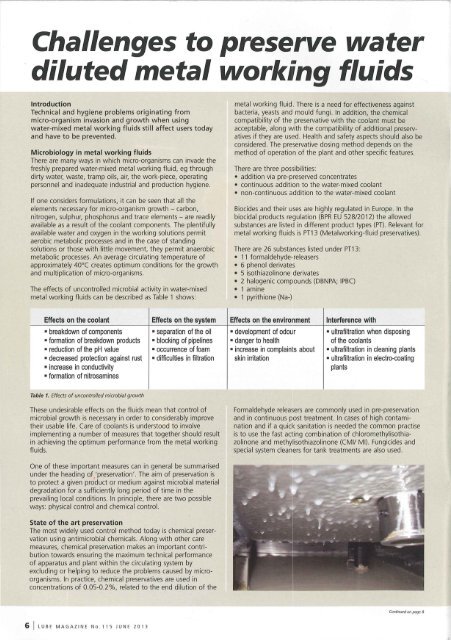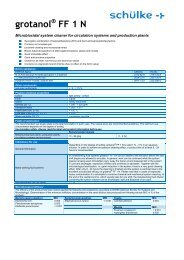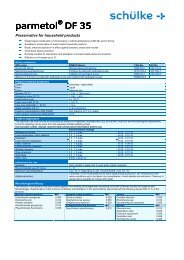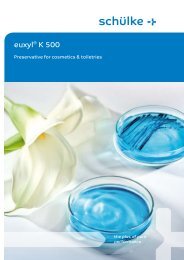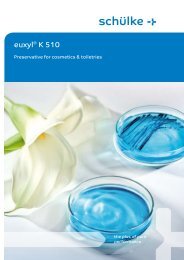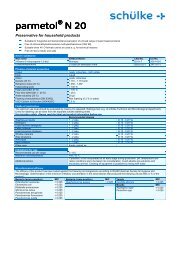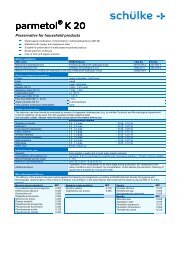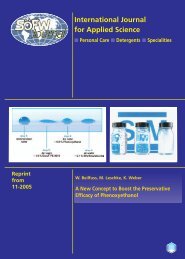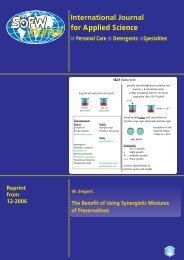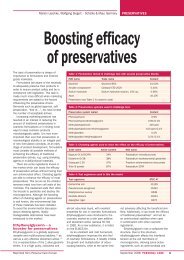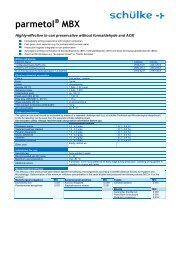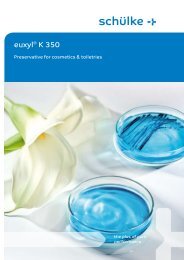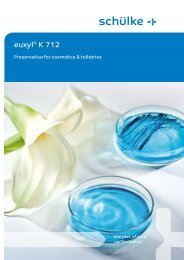Article: Challenges to preserve water diluted metal working fluids
Article: Challenges to preserve water diluted metal working fluids
Article: Challenges to preserve water diluted metal working fluids
Create successful ePaper yourself
Turn your PDF publications into a flip-book with our unique Google optimized e-Paper software.
<strong>Challenges</strong> <strong>to</strong> <strong>preserve</strong> <strong>water</strong><strong>diluted</strong> <strong>metal</strong> <strong>working</strong> <strong>fluids</strong>IntroductionTechnical and hygiene problems originating frommicro-organism invasion and growth when using<strong>water</strong>-mixed <strong>metal</strong> <strong>working</strong> <strong>fluids</strong> still affect users <strong>to</strong>dayand have <strong>to</strong> be prevented.Microbiology in <strong>metal</strong> <strong>working</strong> <strong>fluids</strong>There are many ways in which micro-organisms can invade thefreshly prepared <strong>water</strong>-mixed <strong>metal</strong> <strong>working</strong> fluid, eg throughdirty <strong>water</strong>, waste, tramp oils, air, the work-piece, operatingpersonnel and inadequate industrial and production hygiene.If one considers formulations, it can be seen that all theelements necessary for micro-organism growth - carbon,nitrogen, sulphur, phosphorus and trace elements - are readilyavailable as a result of the coolant components. The plentifullyavailable <strong>water</strong> and oxygen in the <strong>working</strong> solutions permitaerobic metabolic processes and in the case of standingsolutions or those with little movement, they permit anaerobicmetabolic processes. An average circulating temperature ofapproximately 40°C creates optimum conditions for the growthand multiplication of micro-organisms.The effects of uncontrolled microbial activity in <strong>water</strong>-mixed<strong>metal</strong> <strong>working</strong> <strong>fluids</strong> can be described as Table 1 shows:<strong>metal</strong> <strong>working</strong> fluid . There is a need for effectiveness againstbacteria, yeasts and mould fungi. In addition, the chemicalcompatibility of the preservative with the coolant must beacceptable, along with the compatibility of additional preservativesif they are used. Health and safety aspects should also beconsidered. The preservative dosing method depends on themethod of operation of the plant and other specific features.There are three possibilities:• addition via pre-<strong>preserve</strong>d concentrates• continuous addition <strong>to</strong> the <strong>water</strong>-mixed coolant• non-continuous addition <strong>to</strong> the <strong>water</strong>-mixed coolantBiocides and their uses are highly regulated in Europe. In thebiocidal products regulation (BPR EU 528/2012) the allowedsubstances are listed in different product types (PT). Relevant for<strong>metal</strong> <strong>working</strong> <strong>fluids</strong> is PT13 (Metal<strong>working</strong>-fluid preservatives).There are 26 substances listed under PT13:• 11 formaldehyde-releasers• 6 phenol derivates• 5 isothiazolinone derivates• 2 halogenic compounds (DBNPA; IPBC)• 1 amine• 1 pyrithione (Na-)Effects on the coolant• breakdown of components• formation of breakdown products• reduction of the pH value• decreased protection against rust• increase in conductivity• formation of nitrosaminesEffects on the system• separation of the oil• blocking of pipelines• occurrence of foam• difficulties in filtrationEffects on the environment• development of odour• danger <strong>to</strong> health• increase in complainis aboutskin irritationInterference with• ultrafiltration when disposingof the coolants• ultrafiltration in cleaning plants• ultrafiltration in electro-coatingplantsTable 1. Effects of uncontrolled microbial growthThese undesirable effects on the <strong>fluids</strong> mean that control ofmicrobial growth is necessary in order <strong>to</strong> considerably improvetheir usable life. Care of coolants is unders<strong>to</strong>od <strong>to</strong> involveimplementing a number of measures that <strong>to</strong>gether should resultin achieving the optimum performance from the <strong>metal</strong> <strong>working</strong><strong>fluids</strong>.Formaldehyde releasers are commonly used in pre-preservationand in continuous post treatment. In cases of high contaminationand if a quick sanitation is needed the common practiseis <strong>to</strong> use the fast acting combination of chloromethylisothiazolinoneand methYlisothiazolinone (CMII MI). Fungicides andspecial system cleaners for tank treatments are also used.One of these important measures can in general be summarisedunder the heading Qf .'preservation'. The aim of preservation is<strong>to</strong> protect a given product or medium against microbial materialdegradation for a sufficiently long period of time in theprevailing local conditions. In principle, there are two possibleways: physical control and chemical control.State of the art preservationThe most widely used control method <strong>to</strong>day is chemical preservationusing antimicrobial chemicals. Along with other caremeasures, chemical preservation makes an important contribution<strong>to</strong>wards ensuring the maximum technical performanceof apparatus and plant within the circulating system byexcluding or helping <strong>to</strong> reduce the problems caused by microorganisms.In practice, chemical preservatives are used inconcentrations of 0.05-0.2%, related <strong>to</strong> the end dilution of theContinued on page 861 LUB E MAGAZINE No . II S J UN E 2 013
Continued from page 6Legislative challengesRegulation in Europe is strictly governed by the Biocidal ProductDirective (BPD) which "concerns the authorisation and theplacing on the market for use of biocidal products within theMember States" (DIRECTIVE 98/8/EC <strong>Article</strong> 1 a). The BPD willbe replaced 1 st September 2013 by the Biocidal ProductRegulation (BPR). This is an update of the BPR with even higherrequirements and is obliga<strong>to</strong>ry for all states of the EuropeanUnion. The BPR is much stricter for example regarding ~heexclusion criteria for actives (<strong>Article</strong> 5 of the BPR).The BPR requires an evaluation of the eco <strong>to</strong>xicity and as of<strong>to</strong>day, not even one active substance is completely evaluatedand approved. In this context it is an interesting question <strong>to</strong> askhow many of the actives in PT 13 will survive ?There are also other regulations which will have an impact onthe future of <strong>metal</strong> <strong>working</strong> fluid preservation. One specificallyaffects the use of sensitising substances.The 2nd ATPThe 2nd ATP of the CLP Regulation 1272/2008, which is validfrom the 1 st June 2015, contains additional labellingrequirements regarding sensitising substances in mixtures. Theadditional statement for sensitising substances applies <strong>to</strong> thosewith a specific concentration limit lower than 0.1 %. The newlabelling concentration limit is set at one tenth (1/10) of thespecific concentration limit. Above this level of addition themixture has <strong>to</strong> be labelled with: EU H 208 "Contains (name ofthe sensitising substance); May produce an allergic reaction" .Sensitising substances, e.g . CMI/MI, BIT and OIT already possessa special concentration limit regarding sensitisation below 0.1 %.Hence, products containing these substances at a concentrationabove 1/10 of the specific concentration limit have <strong>to</strong> belabelled with the EU H208.Table 2 displays the current as well as the prospective labellinglimits according <strong>to</strong> the 2nd ATP.parme<strong>to</strong>l'" MBXOne innovative and successful new preservative for <strong>metal</strong><strong>working</strong> <strong>fluids</strong> is parme<strong>to</strong>l'" MBX from SchOlke &.Mayr GmbHbased in Norderstedt, Germany (SchOlke). It's free offormaldehyde releasers and chlorine and combines a fast actingsanitisation effect with long term protection. A 0.2% posttreatment addition in the emulsion is free of H208 labelling butis effective enough <strong>to</strong> replace the commonly used CMI/MI.parme<strong>to</strong>l'" MBX has shown excellent results in the labora<strong>to</strong>ry andfield· trials and is already being used in central European plants.ConclusionTo protect <strong>metal</strong> <strong>working</strong> <strong>fluids</strong> against microbiological growthand its undesirable consequences biocidal actives are needed inthe system.The choice of preservatives is limited by European legislationand it could be that the number of actives will be reduced evenmore in the future due <strong>to</strong> the new and higher requirementsfrom the BPR. Furthermore, the use of, for example CMI/MI forpost treatment will require an EU H208 labelling when the 2ndATP comes in<strong>to</strong> force in mid 2015 . One viable alternative is thenew product parme<strong>to</strong>l'" MBX which gives excellent posttreatment results used at a label free addition rate .ICurrent situationSensitising substances withspecial concentration limits lowerthan 0.1 % in the final productActives % ppmCMI/MI


